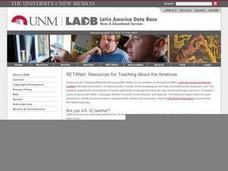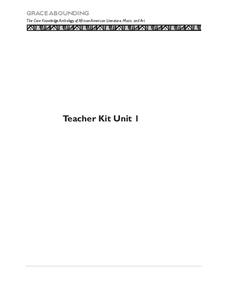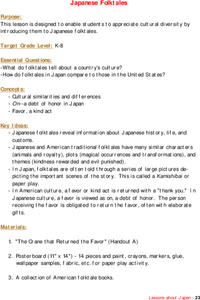Curated OER
When Turtle Grew Feathers
Students explore the Choctaw Native American tribe. In this cross curriculum literacy and U.S. history lesson, students locate where the Choctaw Indians lived on a United States map. Students listen to When Turtle Grew Feathers and...
Curated OER
Comparative Folktales
Young scholars analyze Mongolian and Native American folktales and compare the two types. They discuss the importance of storytelling in nomadic cultures and read a story in small groups. Following the story, they answer questions and...
National Endowment for the Humanities
Folklore in Zora Neale Hurston's Their Eyes Were Watching God
Learners define folklore, folk groups, tradition, and oral narrative. They identify traditional elements in Their Eyes Were Watching God Analyze and understand the role of traditional folkways and folk speech in the overall literary...
Curated OER
African Folktales
High schoolers read African folktales. In this literature lesson, students share prior knowledge about South Africa, Morocco, and Nigeria. Then high schoolers work in groups to read an assigned African folktale and answer response...
Curated OER
American Folktales
Fourth graders read and interpret an American Folktale. Students create their own folktale about Indiana. Students use digital cameras and clipart from the computer to create a photo story. Students present their animated folktales to...
Annenberg Foundation
Exploring Borderlands
What motivated Europeans to explore the New World, and what effects did their exploration have on Native American populations? The second installment of a 16-part American Passages series prompts pupils to watch a video and read several...
Curated OER
Folktales: "The Storytelling Stone"
Students create a folktale after finding out the importance of folktales in different cultures. In this folktales instructional activity, students determine the definition of a folktale and read a "The Storytelling Stone." Students...
Curated OER
Electronic Journals about Latin American Folktales
Students exchange folktales with a key-pal using dialog journal writing. They write out a folktale from their own cultural background and exchange it with students of another. They record their impressions of each other's folktales.
Curated OER
Teacher Kit Unit 1
Nine lessons makeup a unit designed to reinforce grammar and vocabulary through practice pages based on readings of African folktales. Each lesson consists of a mini lesson, a vocabulary review, and a learning exercise. Topics include...
Curated OER
Dramatizing Folktales, Legends and Myths
Learners read different folktales from Native American cultures. They work together to act out different scenes. They discover the difference between folktales, legends and myths.
Curated OER
Japanese Folktales
Students identify that Japanese folktales reveal information about Japanese history, life, and customs. Students identify and interpret the work kamishibai, paper play and explain that in Japanese folktales are told through a series of...
Curated OER
Comparing African, American, and European Folktales
Students find compare an African, Native American, and European folktale. In this folktale lesson, students listen to three different folktales before finding the similarities and differences in them. They complete a worksheet of...
Curated OER
American Folklore
Students develop an idea about American Folk heroes. Individual slideshows are going to be made by each student to be viewed by their peers. Students also have an opportunity to take part in role play situations from various folklores.
Curated OER
Understanding Folklife and Folklore
Student examine the basic characteristics of folklore. In this folklore instructional activity, students complete activities to identify two kinds of folk, folk groups, and folklife. Students list daily activities in their home, identify...
Curated OER
Folktales: Oral Traditions as a Basis for Instruction in our Schools
Students visit their school library to read a variety of folktales. While they read, they identify the trickster or hero in each and discuss how the character represents the chaos in the real world. In groups, they write their own...
Curated OER
Folktales
Fourth graders read a Haitian folktale. They study main characters in Haitian folktales and explore multicultural information about Haiti. They clarify understanding by retelling a sentence (paraphrasing) and a passage in their own...
Curated OER
Learning About the Kumeyaay Indians
Third graders research the Native American nation of Kumeyaay. Scholars use the internet to research past history. Through email, 3rd graders communicate with a Kumeyaay child to discover life on a present day reservation. They create a...
Curated OER
Border Legends, Myth, & Folklore
Students examine the narrative forms and tales unique to the U.S.-Mexico border. They discuss the possible sociological meanings of these stories, and then write their own versions to demonstrate that they explain the forms.
Curated OER
Johnny Appleseed & Miss Rumphius
Young scholars read American folktales. They explore and discuss the characteristics of a folktale. Students construct a Venn Diagram to compare/contrast Lupine Lady and Johnny Appleseed. Class diagrams will be displayed.
Curated OER
Tall Tales: Larger Than Life Stories
Review the elements of tall tales with your class. Take a look at their genesis and purpose. Different types of figurative language found in tall tales are included such as hyperbole, simile, and metaphor. Before reading an American tall...
K20 LEARN
Here's How I Heard It: Using Folklore To Improve Close Reading Skills
"X" is for exaggeration, and "F" is for fact. To encourage close reading and to improve literary analysis skills, class members annotate fables and tall tales, like Paul Bunyan, with symbols that identify key features of this genre.
Curated OER
How Grandmother Spider Stole the Sun
Students explore U.S. history by reading a Native American tale in class. In this cultural storytelling lesson, students read the story How Grandmother Spider Stole the Sun and discuss the characters and themes of the Native American...
Curated OER
Storytelling of the Four Tribes of Nevada
Learners work in groups to identify the major characters and events found in a Nevada Native American folklore story. Each of the groups takes on the role of a different tribe, and they are given a story from that tribe's oral history....
Curated OER
Traditions and Languages of Three Native Cultures: Tlingit, Lakota, and Cherokee
Students explore the connections between tradition and language. They examine the environment, history and culture of the Tlingit, Lakota and Cherokee tribes and identify the importance of maintaining languages for oral traditions.
Other popular searches
- Asian American Folktales
- Native American Folktales
- African American Folktales
- Latin American Folktales
- Foafrican American Folktales
- Irish American Folktales
- African American Folktales

























